Contents
Of all fodder root crops, fodder carrots occupy the first place. Its difference from the equally common fodder beet is that it is not only more nutritious, but also more unpretentious in care. One root crop of fodder carrots contains almost all known vitamins and amino acids. Due to its rich vitamin composition, it is actively used in feed for animals and birds.
The composition and benefits of fodder carrots
Feed carrots contain a large amount of vitamins and minerals. But they stand out in particular in its composition:
- carotene;
- vitamin C;
- vitamins of group B;
- vitamin E;
- calcium;
- boron;
- silicon and others.
It should be noted that not only the root crop itself is rich in vitamins, but also its tops. It contains even more manganese, iodine and protein than the carrot itself.
Carrots of fodder varieties and its tops are perfectly absorbed by animals and birds. Their introduction into the diet contributes to better digestion of other feeds. It is this fodder root crop that is able to enhance the formation of milk, which is especially important for animals of dairy breeds.
Characteristics of varieties
All varieties of fodder carrots are usually divided into three groups according to their color:
- white;
- yellow;
- red.
At the same time, it is difficult to single out an absolute leader among these fodder varieties. The most productive varieties will be white, then yellow and red. But in terms of dry matter content, the order of leadership will be reversed: red, yellow, and only then white.
Consider the varieties of each of these groups.
White varieties
These fodder varieties are the most common and largest – up to 4 kg. At the same time, the average length of carrots can reach 50 cm, and its neck can have a thickness of 8 cm. The percentage of dry matter in carrots of these varieties will not exceed 12%, sugar will be about 3%.
White Belgian

Only the tops of the White Belgian protrude above the surface. The long carrots of this fodder variety are cone-shaped and hidden underground from view.
White green-headed
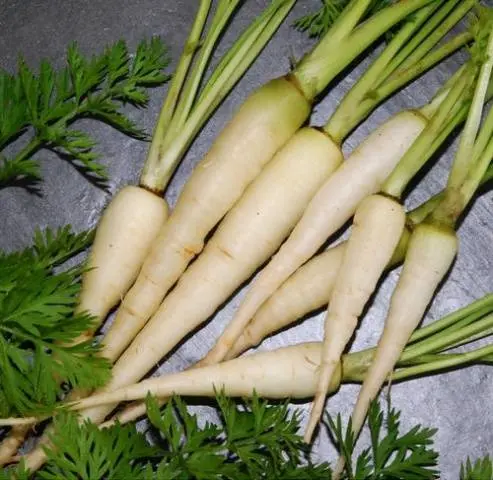
The lush tops of this fodder variety are formed by dark green erect leaves with green petioles.
But this can only happen when grown on heavy soils and with prolonged exposure to low temperatures.
The white carrot of this variety got its name because of the green color of its top. In its shape, it resembles an elongated cone, which is hidden underground by 2/3. The pulp of carrots is white and very juicy.
gigantic white

The rich tops of carrots consist of erect leaves on long petioles. Some plants have an underdeveloped stem part. Carrots of this variety have an elongated conical shape and a white color with a green top. The white flesh of the Giant White is distinguished by its juiciness.
Arnimkrive white
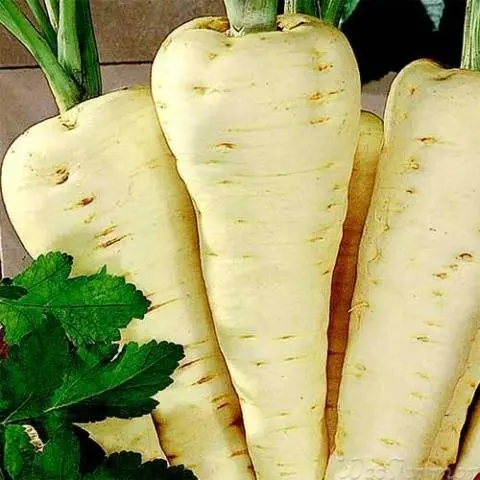
The white roots of this fodder variety are elongated cone shaped and completely sunk into the ground. They are skillfully hidden by thick tops of raised green leaves. White pulp is characterized by medium juiciness.
White varieties of fodder carrots also include:
- White Weibull;
- Championship;
- Thick;
- Berlin giant.
yellow varieties
They are in second place in terms of yield and dry matter content – up to 13%. Sugar of these fodder varieties will be up to 5%.
Belgian yellow
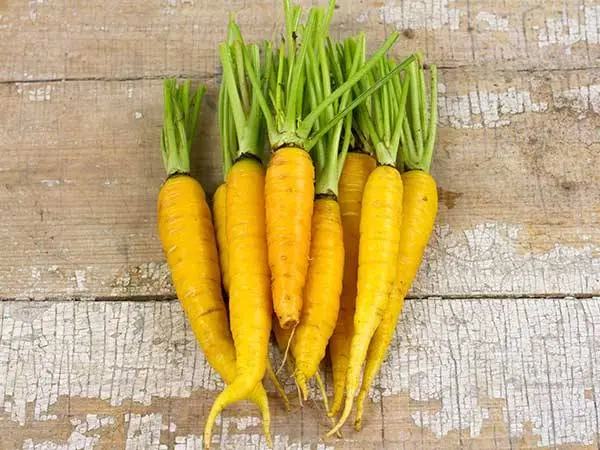
Just like the Belgian white, it is very difficult to clean. The conical root crop of this variety has a slightly blunt bottom and is securely hidden under abundant tops.
Lobberich yellow
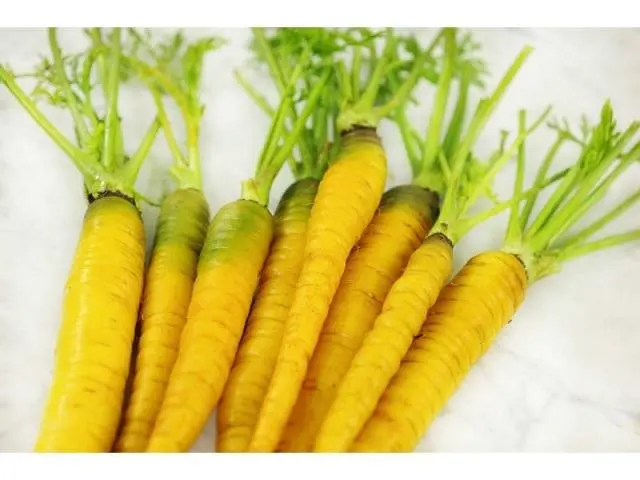
The tops of this variety, in contrast to its stem part, are well developed. It consists of erect leaves on long petioles. Lobberich yellow carrots are quite long and strongly pointed. It practically does not protrude above the surface of the earth. The color of the root crop is heterogeneous: the dark green top smoothly flows into the yellow bottom. Its flesh is also yellow.
Saalfelder yellow
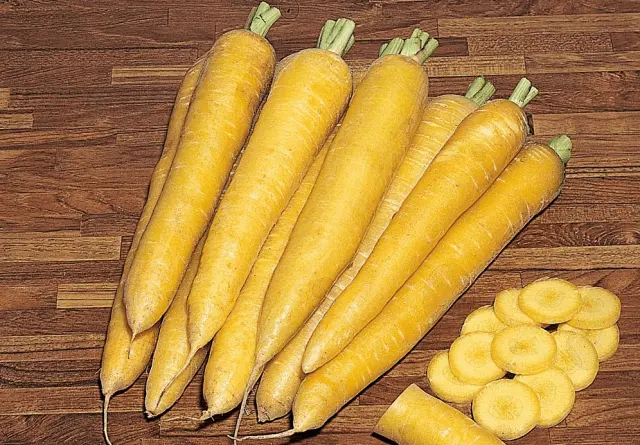
Unlike the previous variety, the shape of this fodder carrot is not so sharp, although it is also elongated. It is yellow and completely submerged in the soil. The light yellow flesh of the variety has medium juiciness.
The yellow varieties of fodder carrots also include:
- Long green-headed giant;
- Palatinate golden yellow;
- Flanders;
- Yellow giant Weibul.
Red varieties
These varieties hold the record for dry matter content of all fodder carrot varieties – up to 15%. Sugar in them will not exceed 5%.
Bull’s Heart
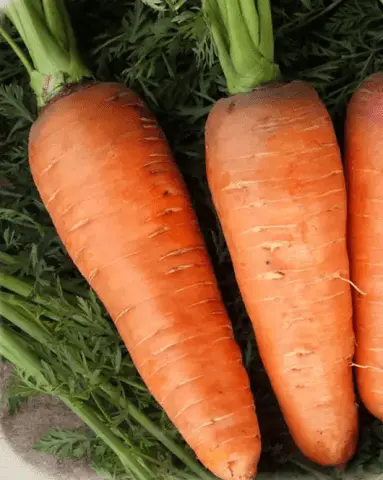
The bull heart has almost no tops and does not produce flower shoots in the first year of vegetation. The root crop of this variety has an oval shape slightly narrowed downwards. Its lower part is slightly rounded. The surface of the root crop, like its pulp, is red.
gigantic red
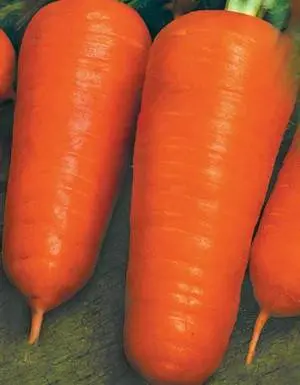
This variety cannot boast of lush tops of erect leaves with green petioles. In addition, its stem part is not developed.
The root crop of this variety, almost completely hidden underground, has the shape of an elongated cone. In this case, only its upper part, painted green, will be visible. The lower part of the root crop has a red color. The flesh of the Giant Red is a pleasant yellow color.
red thick

This is one of those fodder varieties that only have half the leaves standing. The other half is in a reclining position. At the same time, both halves of the tops have long green petioles. A red-pink elongated conical root crop practically does not protrude above the ground. The flesh of this variety has a red color. It is quite juicy and without visible damage.
Red varieties of fodder carrots also include:
- Long orange-red giant;
- Orange-yellow Dippe;
- Long red Brunswick;
- A long fat blunt giant.
Table varieties grown for fodder purposes
There are not so many such varieties used in Our Country, about 10 pieces. This is primarily due to their increased productivity. Consider the most common of them.
The Biryuchek 415

An excellent unpretentious and high-yielding variety. Able to actively bear fruit even in dry areas. Harvest Biryuchekutskaya 415 can be harvested after 2,5 months from the first shoots. The orange root crop has the shape of a cone, up to 16 cm long and weighing up to 120 grams. The flesh is also orange, and with good taste characteristics. A distinctive feature of these root crops is their excellent preservation even during long-term storage.
Vitamin 6

The main characteristic of Vitamin 6 carrots is a high content of carotene, up to 28 mg. The carrot itself, as well as its flesh with a core, are orange in color. In its shape, it looks like a blunt-ended cylinder with a length of up to 20 cm and a diameter of up to 4 cm. There are small grooves on its surface, but in general it is smooth. Perfect for long term storage.
Unparalleled
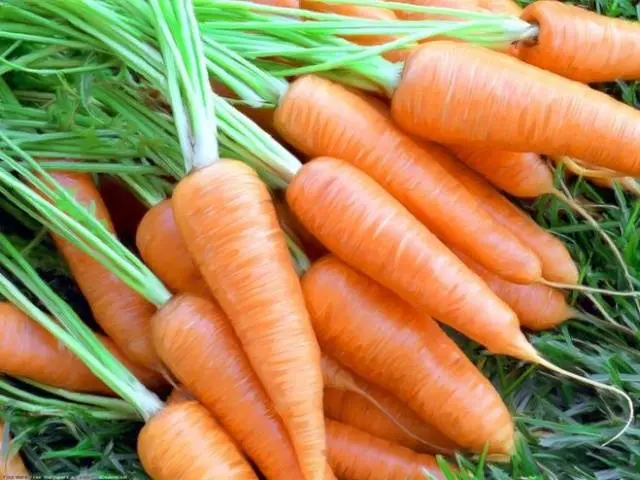
The long bright orange carrots of this variety are cylindrical in shape with a blunt tip. Its length will be about 20 cm, and weight up to 200 grams. It is incredibly productive and has good immunity to many diseases. In addition, the gardener will not see her flower shoots until the second year of vegetation.
Recommendations for growing
Carrots of fodder varieties are a fairly unpretentious crop. Most often it is grown on an industrial scale, but it is not uncommon for it to be planted in ordinary areas. Especially where all kinds of livestock are kept.
This root crop is undemanding to the landing site. It grows especially well on lighted loamy and sandy soils of fertile composition.
If the soil is heavy, then adding peat, sand or matured compost will help improve its composition.
If crop rotation is organized on the site, then the best predecessors for this crop will be:
- beet;
- potatoes;
- cereals and legumes.
Excellent results are shown by planting fodder carrots after green manure. Fodder carrots can also be successfully planted on beds of winter crops after they have been harvested.
In addition, they are great as mulch and green manure for beds. The most common are rapeseed, flax and mustard.
This fodder root crop cannot be planted in one area for more than 5 years in a row. This ban is associated with significant depletion of the soil. If you plant this crop in one place for a long time, then its yield will drop sharply. It will be susceptible to various diseases and pests.
To avoid this, it is recommended to take a break every 3 years and plant other crops on the carrot bed. Moreover, carrots are an excellent predecessor for many of them.
Before sowing the seeds of fodder carrots, you need to prepare a garden bed:
- When carrying out the autumn digging of the soil, in the spring it is no longer necessary to prepare a garden bed. It is enough to slightly loosen it with a chopper.
- If the soil was not dug up in the fall, then this is done in the spring. In this case, it is desirable to choose the roots of other plants.
Seeds of fodder carrots are sown in early spring, as soon as the soil thaws. This culture is cold-resistant, so you can not be afraid of sudden spring frosts.
For those who sow seeds according to the lunar calendar, the waning moon will be the best time to plant this root crop. For the rest, it is recommended to meet the deadlines from April 20 to May 10.
When the soil is prepared, the gardener can start sowing:
- Furrows must be made in the selected place. The optimal distance between the furrows will be a distance of 20 cm, and the depth should not exceed 1 cm.
- The furrows are shed with warm water.
- After the soil has absorbed water, seeds can be sown. Sowing is done no more than 1 cm.
- From above, the furrows are sprinkled with soil. You can also use peat.
Further care of root crops is quite simple. They only need:
- Moderate regular watering. As a rule, this crop should be watered no more than once every 2 days in normal weather. In dry weather, watering is done daily, and in cloudy weather – once a week.Advice! It is better to water in the evening.
- thinning. It is produced twice: after 14 days and after 8 weeks from emergence. In the first thinning between young plants, no more than 3 cm is left, in the second – no more than 5 cm. All empty holes from plucked plants must be filled with earth.
- Top dressing. To do this, use any nitrogen mineral fertilizers, urea and potassium sulfate.
Harvesting fodder carrots can be done both by hand and by machine, depending on the amount of sowing.
Only whole, undamaged root crops are left for storage. For better preservation, it is necessary to provide them with a temperature not higher than +2 degrees and a humidity of 90-95%.
How best to store carrots can be found in the video:









